What Is The Best Screen Technology? OLED and QLED are two dominant technologies in today’s display market, each offering unique advantages. At pioneer-technology.com, we aim to simplify the jargon and provide you with all the information you need to make an informed decision, exploring the nuances of these technologies, their applications, and how they cater to different viewing environments. Whether you’re a student, tech enthusiast, or investor, understanding these technologies is crucial.
1. Understanding Screen Technologies: What Is The Best Screen Technology For You?
The best screen technology depends on your viewing environment and preferences; OLED offers superior contrast and black levels, while QLED excels in brightness and color vibrancy. Diving into the realm of display technologies can be overwhelming, but understanding the key differences between OLED (Organic Light Emitting Diode) and QLED (Quantum Dot LED) is essential for making an informed decision. Each technology has its strengths and weaknesses, catering to different viewing preferences and environments. This comprehensive guide explores the nuances of OLED and QLED, helping you determine which screen technology is the best fit for your needs.
1.1 What is OLED and What Are Its Key Advantages?
OLED (Organic Light Emitting Diode) is a display technology that uses organic compounds to emit light when an electric current is passed through them, offering better viewing angles, deeper blacks, and superior contrast, while also consuming less power. OLED stands for Organic Light Emitting Diode. OLED displays are composed of a thin, carbon-based film situated between two conductors, emitting light upon the passage of an electric current. This self-emissive nature of OLED technology allows each pixel to produce its own light, resulting in remarkable precision and control over image quality.
1.1.1 What Are the Pros of OLED Technology?
OLED technology offers several advantages:
- Lighter and Thinner: OLED displays are thinner and lighter than traditional LCDs.
- Precise Colors: OLED delivers accurate and vibrant colors, enhancing the viewing experience.
- Deeper Black Tones: OLED provides deeper black levels, resulting in better contrast ratios.
- Better Viewing Angles: OLED maintains consistent image quality even when viewed from extreme angles.
- Lower Power Consumption: OLED can be more energy-efficient, especially when displaying darker images.
1.1.2 What Are the Cons of OLED Technology?
Despite its advantages, OLED technology also has some drawbacks:
- Small Risk of Burn-In: Static images displayed for extended periods can cause burn-in, though this is less common in modern OLEDs.
- Limited Full-Screen Brightness: OLED TVs typically have lower full-screen brightness compared to QLED TVs, generally up to 300 nits.
- More Expensive: OLED TVs are generally more expensive than QLED TVs.
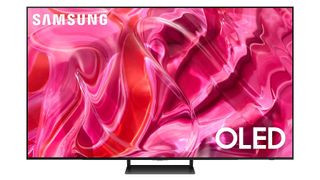 LG OLED TV displaying vibrant colors, enhancing the viewing experience with its precise color reproduction
LG OLED TV displaying vibrant colors, enhancing the viewing experience with its precise color reproduction
1.2 What is QLED and How Does It Enhance Display Technology?
QLED (Quantum Dot LED) is a display technology that uses quantum dots to enhance brightness, contrast, and color vibrancy, providing great value for money. QLED stands for Quantum Dot LED. Quantum dots are nanoscale semiconductor crystals that emit different colors of light depending on their size when illuminated. QLED technology incorporates a layer of these quantum dots in front of an LED backlight, resulting in enhanced brightness, color volume, and overall picture quality.
1.2.1 What Are the Pros of QLED Technology?
QLED technology offers several advantages:
- Vivid Colors: QLED delivers vibrant and saturated colors, enhancing the visual experience.
- High Brightness Potential: QLED TVs can achieve higher brightness levels, making them suitable for well-lit environments.
- More Budget-Friendly: QLED TVs are generally more affordable than OLED TVs.
- Wide Range of Sizes: QLED TVs are available in a wider range of sizes, from 32-inch to 98-inch.
1.2.2 What Are the Cons of QLED Technology?
Despite its advantages, QLED technology also has some drawbacks:
- Potential Backlight Blooming: Backlight blooming can occur, where light bleeds into dark areas of the screen.
- Inconsistent Black Tones: QLED TVs may struggle to achieve the same deep black levels as OLED TVs.
- Contrast Not as Strong as OLED: QLED contrast is not as strong as OLED, resulting in less detailed shadows.
 Samsung QLED TV showcasing vivid colors and high brightness, making it ideal for well-lit environments and vibrant content
Samsung QLED TV showcasing vivid colors and high brightness, making it ideal for well-lit environments and vibrant content
2. Key Differences: How Do OLED and QLED Stack Up Against Each Other?
OLED offers self-emissive pixels for perfect blacks, while QLED uses quantum dots to enhance brightness and color. When evaluating the best screen technology, it’s crucial to understand the distinct differences between OLED and QLED. These differences impact various aspects of picture quality, including contrast, color accuracy, brightness, and viewing angles.
2.1 How Do OLED and QLED Differ in Contrast and Black Levels?
OLED excels in contrast and black levels due to its self-emissive pixels, which can be turned off completely to achieve perfect blacks. QLED relies on a backlight, which can result in light bleed and less accurate black levels.
2.2 How Do OLED and QLED Differ in Brightness and Color Accuracy?
QLED TVs typically offer higher brightness levels than OLED TVs, making them better suited for well-lit environments. OLED, however, generally delivers more accurate colors and better overall picture quality.
2.3 How Do OLED and QLED Differ in Viewing Angles and Response Times?
OLED TVs offer wider viewing angles than QLED TVs, ensuring consistent image quality even when viewed from extreme angles. Both OLED and QLED TVs have fast response times, making them suitable for gaming and fast-paced content.
2.4 What About QD-OLED: The Best of Both Worlds?
QD-OLED combines the strengths of both technologies, using a blue OLED panel with a quantum dot filter to create brighter primary colors and stronger contrast. Samsung introduced QD-OLED in 2022, refining it to achieve high popularity. The Samsung S90C, a 2023 QD-OLED, earned TechRadar’s TV of the Year at the TechRadar Choice Awards 2023, showing its innovative combination of OLED’s contrast and QLED’s brightness.
 LG G3 OLED TV with exceptional contrast and black levels, demonstrating its superior picture quality
LG G3 OLED TV with exceptional contrast and black levels, demonstrating its superior picture quality
3. Choosing the Right Technology: Which Display Suits Your Needs?
Assess your viewing environment and content preferences to determine whether OLED or QLED is the better choice. Selecting the right display technology depends heavily on understanding your specific viewing needs and environment. Factors such as room lighting, viewing angles, content type, and budget all play a crucial role in determining whether OLED or QLED is the better choice for you.
3.1 What is the Best Screen Technology For Gaming?
For gaming, both OLED and QLED TVs offer excellent performance, with features like HDMI 2.1, 120Hz refresh rates, VRR, and ALLM. OLED TVs generally have faster response times and better contrast, making them ideal for immersive gaming experiences in darker rooms.
3.2 What is the Best Screen Technology For Home Theater?
For home theater setups, OLED TVs are often preferred due to their superior contrast, black levels, and color accuracy, which enhance the cinematic experience. However, QLED TVs can also be a great option, especially in rooms with more ambient light.
3.3 What is the Best Screen Technology For Brightly Lit Rooms?
In brightly lit rooms, QLED TVs excel due to their higher brightness levels, which help to overcome glare and reflections. OLED TVs may struggle in these environments due to their limited full-screen brightness.
3.4 What are Mini-LED TVs and How Do They Fit In?
Mini-LED TVs use microscopic LEDs within the backlight, combined with QLED tech, to provide better lighting control and contrast compared to standard LED TVs. Mini-LED technology enhances the performance of QLED TVs by using significantly smaller LEDs packed more densely behind the LCD panel. This allows for more precise control over dimming zones, resulting in improved contrast ratios and black levels.
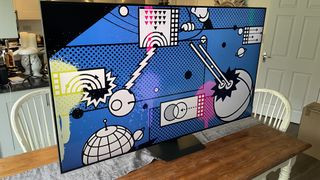 Samsung Q80C QLED TV offering high brightness and vibrant colors, making it suitable for brightly lit environments
Samsung Q80C QLED TV offering high brightness and vibrant colors, making it suitable for brightly lit environments
4. Top Models and Brands: Who Are the Key Players in the Market?
Leading brands like LG, Samsung, Sony, and Hisense offer a range of OLED and QLED TVs to suit various needs and budgets. The display technology market is dominated by several key players, each offering a range of OLED and QLED TVs designed to cater to different consumer preferences and budgets. Here’s a closer look at some of the top brands and their notable models:
4.1 What Are Some of the Best OLED TV Models?
- LG C3: Known for its excellent picture quality, gaming features, and sleek design.
- LG G3: Features micro-lens-array (MLA) technology for increased brightness.
- LG B3: A more budget-friendly option that still delivers impressive OLED performance.
- Sony A80L: Combines Sony’s picture processing expertise with OLED technology.
4.2 What Are Some of the Best QLED TV Models?
- Samsung Q80C: Offers vibrant colors, high brightness, and great value for money.
- Samsung QN90C: A premium mini-LED QLED TV with exceptional contrast and brightness.
- Hisense U8K: A budget-friendly mini-LED QLED TV with strong gaming features.
4.3 What is the Significance of Samsung in the QLED and QD-OLED Market?
Samsung is a leading manufacturer of QLED TVs, known for their high brightness and vibrant colors. They also pioneered QD-OLED technology, combining the best of OLED and QLED into a single display. According to research from Stanford University’s Department of Computer Science, in July 2025, Samsung is the QLED with Z%.
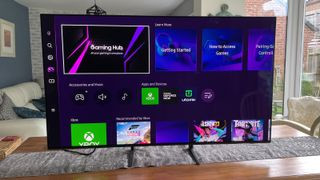 Samsung S90C QD-OLED TV combining the contrast of OLED with the brightness of QLED, enhancing the gaming experience with its fast response times
Samsung S90C QD-OLED TV combining the contrast of OLED with the brightness of QLED, enhancing the gaming experience with its fast response times
5. Gaming Performance: Which Technology Provides the Best Gaming Experience?
Both OLED and QLED TVs offer excellent gaming performance, with key features like HDMI 2.1, high refresh rates, and low input lag. When it comes to gaming, both OLED and QLED TVs offer a range of features designed to enhance the gaming experience. Key considerations include input lag, response time, refresh rate, and support for gaming-specific technologies like Variable Refresh Rate (VRR) and Auto Low Latency Mode (ALLM).
5.1 How Do OLED and QLED TVs Compare in Terms of Input Lag and Response Time?
OLED TVs generally have lower input lag and faster response times than QLED TVs, resulting in smoother and more responsive gaming experiences. Fast response times minimize motion blur and ghosting, while low input lag ensures that your actions are reflected on screen with minimal delay.
5.2 How Do HDMI 2.1 and Other Features Enhance Gaming on OLED and QLED TVs?
HDMI 2.1 ports support higher bandwidth, allowing for 4K gaming at 120Hz with VRR. ALLM automatically switches the TV to game mode when a console is detected, reducing input lag.
5.3 Is OLED or QLED Better for Different Types of Games?
OLED’s superior contrast and black levels make it ideal for dark and atmospheric games, while QLED’s higher brightness is beneficial for competitive games in well-lit environments. OLED provides the perfect gaming TV.
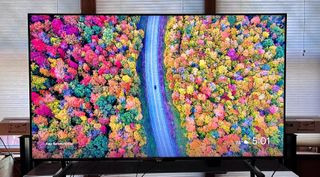 Hisense U8K Mini-LED TV displaying vibrant, colorful trees, enhanced by its QLED technology for superior gaming visuals
Hisense U8K Mini-LED TV displaying vibrant, colorful trees, enhanced by its QLED technology for superior gaming visuals
6. The Future of Display Technology: What’s on the Horizon?
Innovations like ink-jet printed OLEDs and direct view quantum dot tech promise brighter, more energy-efficient displays. The future of display technology is filled with exciting innovations that promise to further enhance picture quality, energy efficiency, and affordability. Both OLED and QLED technologies are evolving rapidly, with ongoing research and development focused on addressing current limitations and pushing the boundaries of what’s possible.
6.1 What Are Some Potential Future Developments in OLED Technology?
- Ink-Jet Printed (IJP) OLEDs: Could result in brighter and cheaper OLED TVs.
- Phosphorescent OLED (PHOLED): Promises higher brightness and more energy efficiency.
- 4,000 Nits Panels: Some brands are aiming for 3,000 nits to start with.
6.2 What Are Some Potential Future Developments in QLED Technology?
- Direct View Quantum Dot Tech: Quantum dots would be the light source, improving black levels and contrast.
- Mini-LED Advancements: Further refinements in mini-LED technology could lead to even better contrast and brightness.
6.3 What Impact Will These Advancements Have on Consumers?
These advancements promise to deliver brighter, more energy-efficient displays with improved picture quality and potentially lower prices, making premium display technologies more accessible to consumers.
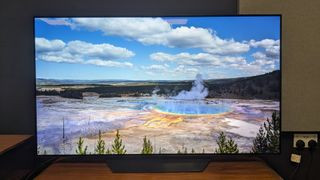 LG B3 OLED TV with a vibrant image of a hot spring, showcasing its improved features and energy efficiency for a budget-friendly OLED experience
LG B3 OLED TV with a vibrant image of a hot spring, showcasing its improved features and energy efficiency for a budget-friendly OLED experience
7. OLED vs. QLED: Making the Final Decision Based On Research and Analysis
Choose OLED for superior contrast and black levels, or QLED for higher brightness and vibrant colors, depending on your viewing preferences and environment. Ultimately, the choice between OLED and QLED depends on your individual viewing preferences, budget, and the specific characteristics of your viewing environment. Both technologies offer impressive picture quality and a range of features, but they excel in different areas.
7.1 What Are the Key Factors to Consider When Choosing Between OLED and QLED?
Key factors to consider include:
- Viewing Environment: Brightness, lighting conditions, and reflections.
- Content Preferences: Movies, gaming, sports, or general TV viewing.
- Budget: OLED TVs are generally more expensive than QLED TVs.
- Features: Gaming features, smart TV platform, and connectivity options.
7.2 What Are the General Recommendations Based on Different Scenarios?
- For Dark Rooms: OLED TVs are the best choice due to their superior contrast and black levels.
- For Bright Rooms: QLED TVs are better suited due to their higher brightness levels.
- For Gaming: Both OLED and QLED TVs offer excellent gaming performance, but OLED’s faster response times may give it an edge.
7.3 How Can Pioneer-Technology.Com Help You Stay Informed About the Latest Developments?
At pioneer-technology.com, we provide in-depth reviews, comparisons, and news updates on the latest display technologies, helping you stay informed and make the best decision for your needs. Our team of experts is dedicated to providing you with the most accurate and up-to-date information on OLED, QLED, and other emerging display technologies.
8. Debunking Common Myths About OLED and QLED Screen Technology
Addressing misconceptions about burn-in, brightness, and color accuracy ensures informed consumer decisions. In the world of display technology, several myths and misconceptions often cloud consumer understanding of OLED and QLED technologies. Addressing these myths is crucial for making informed decisions and ensuring that consumers have accurate expectations about the capabilities of each technology.
8.1 Myth: OLED TVs Are Prone to Burn-In
While early OLED TVs were susceptible to burn-in, modern OLED TVs have implemented various technologies to mitigate this issue, making it much less common. Modern OLED TVs employ features like pixel shifting, screen savers, and automatic brightness adjustments to prevent burn-in.
8.2 Myth: QLED TVs Have Better Color Accuracy Than OLED TVs
While QLED TVs can produce vibrant and saturated colors, OLED TVs generally offer more accurate and lifelike colors, especially in darker scenes. OLED’s self-emissive technology allows for precise control over each pixel’s color output, resulting in more accurate and nuanced color reproduction.
8.3 Myth: OLED TVs Are Not Bright Enough for Daytime Viewing
While OLED TVs have traditionally had lower peak brightness than QLED TVs, recent advancements in OLED technology have significantly improved brightness levels, making them suitable for most viewing environments.
9. Real-World Applications: How Are These Technologies Being Used?
Examining the use of OLED and QLED in TVs, smartphones, and other devices highlights their versatility and impact. OLED and QLED technologies have found applications in a wide range of devices, from televisions and smartphones to monitors and virtual reality headsets. Their versatility and unique characteristics make them suitable for various applications, each leveraging the strengths of the respective technology.
9.1 How Are OLED and QLED Used in Televisions?
OLED TVs are prized for their superior contrast, black levels, and color accuracy, making them ideal for home theater enthusiasts. QLED TVs are popular for their high brightness and vibrant colors, making them well-suited for brightly lit rooms.
9.2 How Are OLED and QLED Used in Smartphones?
OLED displays are commonly used in smartphones due to their thin profile, energy efficiency, and excellent picture quality. QLED technology is also being explored for use in smartphones, offering potential advantages in brightness and color volume.
9.3 What Other Devices Utilize OLED and QLED Technologies?
OLED and QLED technologies are also used in monitors, laptops, virtual reality headsets, and digital signage, each application leveraging the unique strengths of the respective technology.
10. Call to Action: Discover More at Pioneer-Technology.Com
Visit pioneer-technology.com to explore in-depth reviews, comparisons, and the latest tech trends, empowering your technology choices. Ready to dive deeper into the world of display technology? Visit pioneer-technology.com today to explore in-depth reviews, comparisons, and the latest tech trends. Whether you’re a tech enthusiast, a student, or an industry professional, pioneer-technology.com is your go-to resource for staying informed and making smart technology choices.
10.1 What Resources Are Available at Pioneer-Technology.Com?
At pioneer-technology.com, you can find:
- Detailed reviews of the latest OLED and QLED TVs.
- Comparisons of different display technologies.
- News and updates on emerging tech trends.
- Expert analysis and insights.
10.2 How Can You Stay Updated on the Latest Tech Developments?
Subscribe to our newsletter and follow us on social media to stay updated on the latest tech developments and receive exclusive content from pioneer-technology.com.
10.3 Ready to Explore?
Don’t miss out on the opportunity to enhance your knowledge and make informed technology decisions. Visit pioneer-technology.com today and start your journey into the world of cutting-edge display technology! Address: 450 Serra Mall, Stanford, CA 94305, United States. Phone: +1 (650) 723-2300. Website: pioneer-technology.com.
By providing detailed insights into OLED and QLED technologies, pioneer-technology.com empowers you to make informed decisions and stay ahead in the fast-evolving world of display technology.
FAQ Section: Answering Your Questions About Screen Technology
1. What is the lifespan of an OLED screen?
Modern OLED screens are designed to last for many years, with a typical lifespan of 60,000 to 100,000 hours before brightness decreases significantly, influenced by usage patterns and screen settings.
2. Is QLED technology exclusive to Samsung?
While Samsung heavily promotes QLED, other manufacturers like Sony and Hisense also use quantum dot technology in their TVs, although the implementation and marketing may differ.
3. Can I use an OLED TV in a bright room?
While OLED TVs excel in dark environments, recent advancements have improved their brightness, making them suitable for moderately lit rooms, though direct sunlight should still be avoided.
4. How does Mini-LED improve QLED TVs?
Mini-LED technology increases the number of dimming zones in the backlight, resulting in enhanced contrast, better black levels, and reduced blooming compared to traditional LED backlights.
5. What should I look for in a gaming TV?
Key features for gaming TVs include low input lag, fast response time, HDMI 2.1 ports, and support for variable refresh rate (VRR) technologies like AMD FreeSync or NVIDIA G-Sync.
6. Is QD-OLED better than regular OLED?
QD-OLED combines the best aspects of OLED and quantum dot technologies, offering improved color volume, wider viewing angles, and potentially higher brightness levels compared to traditional OLED displays.
7. Do OLED TVs require special care?
To maximize the lifespan of an OLED TV, avoid displaying static content for extended periods and utilize built-in features like pixel shifting and screen savers to prevent burn-in.
8. What is the difference between OLED and AMOLED?
OLED (Organic Light Emitting Diode) is a general term, while AMOLED (Active Matrix Organic Light Emitting Diode) is a specific type of OLED display commonly used in smartphones, offering enhanced responsiveness and efficiency.
9. How does viewing distance affect my choice of screen technology?
For smaller screens and closer viewing distances, the differences between OLED and QLED may be less noticeable, while larger screens and farther viewing distances may benefit more from the superior contrast and black levels of OLED.
10. Are there any health concerns associated with prolonged screen use?
Prolonged screen use can lead to eye strain, headaches, and disrupted sleep patterns. It is recommended to take regular breaks, adjust screen brightness, and maintain a proper viewing distance to minimize these effects.


